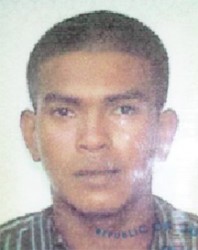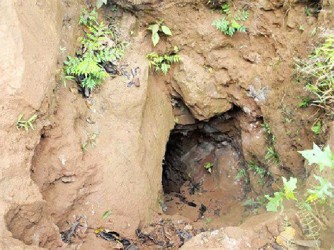Two miners, one of whom was the chairman of the Marudi Miners Association died when the tunnel they were working in at Mazoa Mountain, Marudi, Region Nine caved in yesterday morning.
Dead are Clifton Rodrigues of Marudi and Leon Mootoo, 21, of West Berbice. Fernando Laita, 32, of Aishalton, Deep South Rupununi survived. The body of Rodrigues, who earlier this year became chairman of the Marudi Miners Association, was recovered late yesterday afternoon while Mootoo’s body was recovered earlier in the day. Laita sustained lacerations to the head and bruises about the body and was expected to arrive at the Aishalton District Hospital last night.
The trio was working in a tunnel in the Mazoa Mountain called “The Throne” when it caved in, Stabroek News was told.

Laita’s mother Leonie Laita told Stabroek News that she received the news from a girl who worked at a store in Aishalton at about 9am yesterday. “She tell me that Fernando get cover down,” the woman recalled. She said that an hour later, the girl returned and told her that her son had been pulled out of the caved-in tunnel. “He was still breathing when they found him…he is okay for the time but he got cuts on his head and bruises on his body,” she said. Mootoo is also her nephew and she said that the trio worked together for a while.
Leonie said that her son, nephew and Rodrigues returned to work in the tunnels after the mechanical crusher they made use of, was shut down by the Guyana Geology and Mines Commission (GGMC) recently. Canadian mining company Mulgravian Ventures (Guyana) Inc. (MVGI) has the legal rights to the land at Marudi but an informal understanding has seen locals mining in parts of the MVGI concession.

However, MVGI objected to the use of the mechanical crushers which were introduced recently to the area and the GGMC moved to shut them down. The crusher was based at the foot of the mountain and was owned by someone else and after it was shut down and moved out of the area, the trio returned to the tunnels, Leonie said.
The Guyana Human Rights Association (GHRA) over the weekend before the fatal cave-in had called on the GGMC and the Ministry of Amerindian Affairs (MOAA) to work with the local people to forge a compromise.
Another resident who had worked with Rodrigues on his plans told Stabroek News that the miners association was not registered and they had planned to come to Georgetown later this month to do so. The resident said that there are five mechanical crushers at Marudi and four are owned by locals. MVGI objected to the use of the crushers because the informal understanding was that locals would do “traditional” mining and not use machines, Stabroek News was told. According to the resident, over the years, locals would head to Marudi during the school holidays to do a “fast hustle” to get money for the new school year.
The resident said that a meeting was held two weeks ago and letters were written to the GGMC and MOAA asking if those agencies could broker a compromise on the crushers. The resident explained that the use of the crushers reduced the risk of tunnelling in the mountains. There have been several cave-ins there over the years during which miners died. “Because of the crusher, the people haven’t had to go into the tunnel for the past few months,” the resident said.
According to the resident, with the crushers, the miners did not work the tunnels but crushed the black sand from previous mining operations. “It was previously worked black sand.” It was explained that the

batelling which was done in those spots previously did not allow for the retrieving of all the gold. “Through the batelling process you cannot extract all the gold from the sand,” the resident explained. However, with the crushers, the gravel and sand that comprise the “black sand” were crushed and thus the gold that was left over was extracted.
The resident said that the GGMC officers based there did not seem to have a problem when the pieces of equipment were introduced but did raise the need for environmental safeguards to be implemented and the miners had agreed. The miners preferred to make use of the machine because it was less dangerous than tunnelling, the resident said. “Over the years, the tunnelling of the Mazoa Mountain has weakened it,” she said.
Rodrigues wanted the agencies to broker a compromise because the crushers were seen as safer, the resident said. The now dead man lived for over 30 years at Marudi, Stabroek News was told.
Up to last evening, the bodies of the men had not been brought to Aishalton though arrangements were being made to have them brought out. GGMC officials based at Marudi were informed of the incident, Stabroek News was told.





